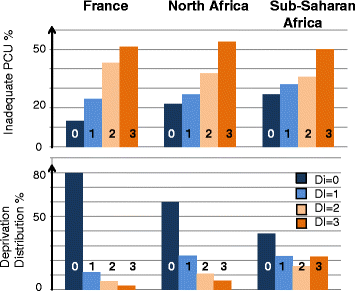Association between maternal social deprivation and prenatal care utilization: the PreCARE cohort study
- PMID: 28506217
- PMCID: PMC5433136
- DOI: 10.1186/s12884-017-1310-z
Association between maternal social deprivation and prenatal care utilization: the PreCARE cohort study
Abstract
Background: Maternal social deprivation is associated with an increased risk of adverse maternal and perinatal outcomes. Inadequate prenatal care utilization (PCU) is likely to be an important intermediate factor. The health care system in France provides essential health services to all pregnant women irrespective of their socioeconomic status. Our aim was to assess the association between maternal social deprivation and PCU.
Methods: The analysis was performed in the database of the multicenter prospective PreCARE cohort study. The population source consisted in all parturient women registered for delivery in 4 university hospital maternity units, Paris, France, from October 2010 to November 2011 (N = 10,419). This analysis selected women with singleton pregnancies that ended after 22 weeks of gestation (N = 9770). The associations between maternal deprivation (four variables first considered separately and then combined as a social deprivation index: social isolation, poor or insecure housing conditions, no work-related household income, and absence of standard health insurance) and inadequate PCU were tested through multivariate logistic regressions also adjusted for immigration characteristics and education level.
Results: Attendance at prenatal care was poor for 23.3% of the study population. Crude relative risks and confidence intervals for inadequate PCU were 1.6 [1.5-1.8], 2.3 [2.1-2.6], and 3.1 [2.8-3.4], for women with a deprivation index of 1, 2, and 3, respectively, compared to women with deprivation index of 0. Each of the four deprivation variables was significantly associated with an increased risk of inadequate PCU. Because of the interaction observed between inadequate PCU and mother's country of birth, we stratified for the latter before the multivariate analysis. After adjustment for the potential confounders, this social gradient remained for women born in France and North Africa. The prevalence of inadequate PCU among women born in sub-Saharan Africa was 34.7%; the social gradient in this group was attenuated and no longer significant. Other factors independently associated with inadequate PCU were maternal age, recent immigration, and unplanned or unwanted pregnancy.
Conclusion: Social deprivation is independently associated with an increased risk of inadequate PCU. Recognition of risk factors is an important step in identifying barriers to PCU and developing measures to overcome them.
Keywords: High-risk pregnancy; Prenatal care utilization; Social deprivation; Social inequalities in health.
Figures

References
-
- Cantwell R, Clutton-Brock T, Cooper G, Dawson A, Drife J, Garrod D, et al. Saving mothers’ lives: reviewing maternal deaths to make motherhood safer: 2006–2008. The eighth report of the confidential enquiries into maternal deaths in the United Kingdom. BJOG. 2011;118(Suppl 1):1–203. - PubMed
Publication types
MeSH terms
LinkOut - more resources
Full Text Sources
Other Literature Sources
Medical

